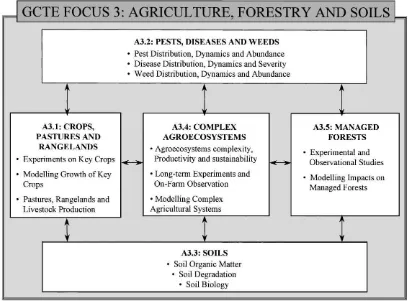Agriculture, Ecosystems and Environment 82 (2000) 1–2
Preface
Food and forestry: global change and global challenges
Agricultural and forestry production have a well established dependence on climate. There is, therefore, growing concern about the potentially wide-ranging impacts that climate change would have on these key industries as the nature and extent of anticipated changes become more evident. “Global Change” how-ever encompasses far more than change in climate alone. It also includes changes in climate variabi-lity and atmospheric composition, and in land use and management (especially changes in the use of nitrogen and water). All these are changing in un-precedented ways both in terms of their rate and their spatial extent.
Changes in land-use are currently the main mani-festation of global change, and these are primarily driven by the increasing demands for agricultural and forest products. Many current land management practises cannot deliver a sustainable supply, let alone increase output, without risking further serious envi-ronmental degradation. Meeting anticipated demand will, therefore, be difficult enough with current man-agement, but it will be further complicated by the independent and interactive impacts of other drivers of global change, especially increases in climate vari-ability, land degradation and pollution. Assessment of these impacts on production systems at a range of spatial and temporal scales is central to developing improved systems that can capitalise on the beneficial effects of global change, while avoiding or reducing adverse effects. This will require the development of a strong predictive capability, which is a formidable research challenge.
In response to these needs there is now a sub-stantial scientific effort worldwide at both national and international levels. To help coordinate this into a coherent research endeavour, and to add value to
the large investment by integrating and synthesising research results, the Global Change and Terrestrial Ecosystems Core Project (GCTE) of the International Geosphere-Biosphere Programme (IGBP) established a programme of research dealing with agriculture, forestry and soils (GCTE Focus 3). Since its launch in 1991, GCTE Focus 3 had developed a number of spe-cialist Tasks and Networks covering the global change research agenda for major monocrops and pasture and rangeland production, for pests, diseases and weeds, for soils, for multi-species agroecosystems, and for managed forests (see Fig. 1).
Output from much of this research has already been published in the scientific literature, and within a synthesis, essentially along disciplinary lines, com-pleted as part of the overall GCTE effort (see Gregory and Ingram, this volume). The challenge now for the global change research community is to develop in-terdisciplinary avenues of work to address issues at a higher level of integration. Two such issues are (i) the environmental consequences of increasing food, fibre and fuel supply; and (ii) how climate variability will affect food and fibre production. These are not only of high scientific interest, but also of high societal con-cern as they deal in part with sustainability and food security, respectively. However, they are scientifically complex due to the many processes and feedbacks involved. Developing tools to explore the impacts of scenarios of changed conditions will require an un-precedented degree of interdiciplinarity for improving simulation models for crop, pasture and forest pro-duction. Of particular concern is how better to repre-sent edaphic (e.g. nutrient and water availability), and biotic (e.g. pests, diseases and weeds) constraints on yield in these models. Important though these efforts are, they are essentially designed to improve models
2 Preface / Agriculture, Ecosystems and Environment 82 (2000) 1–2
Fig. 1. GCTE Focus 3 Activity and Task structure.
for analyses at plot or field scale. To undertake the analyses at larger scales required for policy formu-lation at national and sub-national levels, improved methods for scaling-up results from plot to region are necessary, as is an improved predictive capabi-lity of where future production areas are likely to be found.
Many of the issues summarised above were pre-sented and debated at an International Conference organised by GCTE Focus 3 and Elsevier Science and held at The University of Reading, UK in September 1999. The written papers from the main Conference Sessions are brought together in this Special Issue of Agriculture, Ecosystems and Environment. We are grateful to the many presenters, participants and donors who made the Conference a success in report-ing latest research findreport-ings from GCTE Focus 3 Tasks
and Networks, and helping to establish priorities for future research.
Peter J. Gregory∗
University of Reading P.O. Box 233, Whiteknights Reading RG6 6DW, UK
John S.I. Ingram
GCTE focus 3 Office NERC Centre for Ecology and Hydrology Crowmarsh Gifford, Wallingford Oxfordshire OX10 8BB, UK
∗Corresponding author. Tel.:
+44-118-931-8911; fax:+44-118-931-6666.
E-mail address: [email protected]
